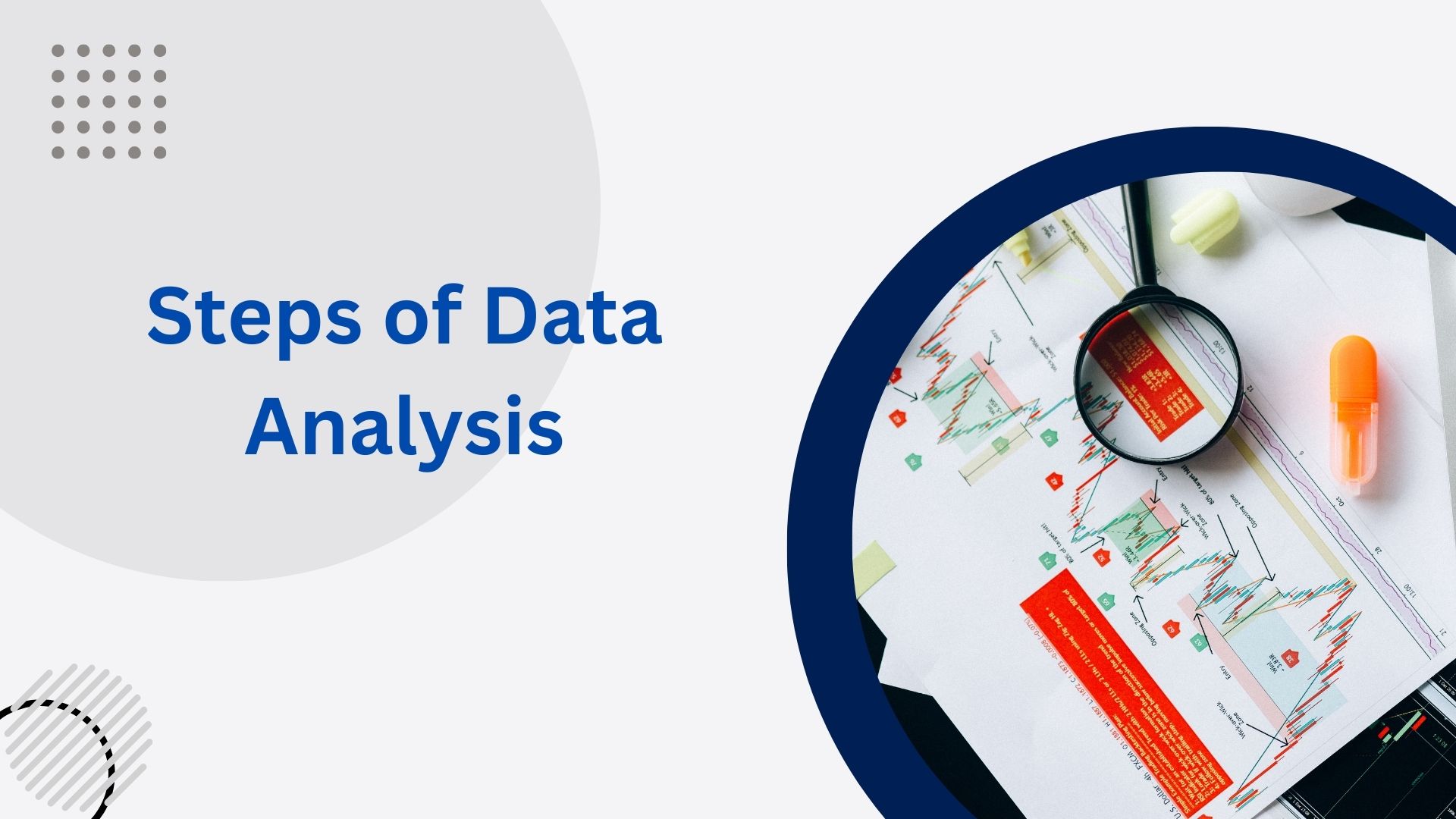Data analysis involves a systematic process of inspecting, cleansing, transforming, and interpreting data to extract meaningful insights. It includes steps such as data collection, data cleaning, data exploration, data modeling, and data visualization to derive valuable conclusions.
Data analysis is a crucial part of decision-making in various fields and industries. From examining market trends to predicting customer behavior, the process helps organizations make informed choices and drive better outcomes. By understanding the steps of data analysis, businesses can harness the power of their data to gain a competitive edge and improve their overall performance.
We’ll explore the essential stages of data analysis, highlighting their significance and how they contribute to unlocking the potential of information for informed decision-making.

Credit: intellek.io
Step 1: Define The Problem
When conducting data analysis, it is essential to start with a clear and well-defined problem. By clearly understanding the problem at hand, you can devise effective strategies and gather relevant data to uncover meaningful insights. In this first step of the data analysis process, there are two important aspects to consider: identifying the objective and formulating research questions.
Identify The Objective
The first step in defining the problem is to identify the objective. What is the main goal or outcome you hope to achieve through data analysis? This objective will guide your entire analysis process and help you stay focused. Whether it’s improving customer satisfaction, increasing sales, or optimizing business operations, a clear objective keeps you on track.
Formulate Research Questions
Once you have identified the objective, the next step is to formulate research questions. These questions serve as a roadmap for your analysis, guiding you towards the necessary data and insights. Research questions help you define the scope of your analysis and provide a structure for your investigation.
When formulating research questions, keep in mind that they should be specific, measurable, achievable, relevant, and time-bound (SMART). For example, if your objective is to improve customer satisfaction, a research question could be: “What are the main factors that influence customer satisfaction?”. This question is specific, measurable, and directly relates to your objective.
Once you have formulated clear research questions, you can proceed to the next steps of the data analysis process, such as data collection, cleaning, and analysis.
Step 2: Collect The Data
When beginning the data analysis process, the second crucial step involves collecting the necessary data. This step lays the foundation for the analysis and must be carried out meticulously to ensure accuracy and reliability in the subsequent stages.
Determine Data Sources
Identifying the appropriate data sources is the first task when collecting data. These sources may include databases, surveys, interviews, and external reports. The suitability and reliability of each source are essential considerations during this phase.
Decide On Data Collection Methods
After determining the sources, the next step is to decide on the specific methods to be used for data collection. These methods can range from manual data entry and surveys to the utilization of automated data collection tools. It is crucial to choose methods that align with the nature of the data and the research objectives.
Step 3: Clean And Prepare The Data
Cleaning and preparing the data is a crucial step in the data analysis process. It involves checking the quality of the data, handling missing data, and ensuring that the dataset is ready for analysis.
Check Data Quality
Before proceeding with the analysis, it is essential to check the quality of the data. This includes looking for inconsistencies, inaccuracies, and anomalies that could affect the integrity of the analysis results.
Handle Missing Data
Dealing with missing data is a critical aspect of data preparation. Missing data can skew the analysis and lead to erroneous conclusions, so it’s important to address this issue effectively.

Credit: www.linkedin.com
Step 4: Analyze The Data
Once you have collected and cleaned your data, the next step is to analyze it. This crucial step involves applying statistical techniques, identifying patterns and trends, and drawing meaningful insights from your data. By systematically analyzing your data, you can uncover valuable information that can guide decision-making and help solve complex problems. Let’s explore the essential sub-steps involved in analyzing data.
Apply Statistical Techniques
Applying statistical techniques is an important part of analyzing data. These techniques allow you to quantify relationships and patterns within your dataset, making it easier to draw meaningful conclusions. Some commonly used statistical techniques include:
- Hypothesis testing: This involves formulating and testing hypotheses to determine if there are any significant differences or relationships between variables.
- Regression analysis: This technique helps you understand the relationship between a dependent variable and one or more independent variables.
- Descriptive statistics: By calculating measures such as mean, median, and standard deviation, you can summarize and describe the main characteristics of your data.
Identify Patterns And Trends
Identifying patterns and trends within your data can provide valuable insights into underlying relationships and potential opportunities. Here are some steps to help you identify patterns and trends:
- Visualize data: Create graphs, charts, or data plots to visually represent your data. This allows you to spot patterns, trends, and outliers more easily.
- Look for correlations: Examine the relationships between variables to identify any meaningful connections. A correlation coefficient can help measure the strength and direction of these relationships.
- Segment data: Divide your data into smaller subsets based on relevant variables. Analyzing these subsets separately may reveal unique patterns or trends hidden within your overall dataset.
By analyzing your data and identifying patterns and trends, you can gain insights that drive strategic decision-making. Remember to choose appropriate statistical techniques and use effective visualization methods to extract the maximum value from your data.
Step 5: Interpret And Communicate The Results
In Step 5 of the data analysis process, the results are interpreted and effectively communicated. This crucial step ensures that the insights derived from the data are understood and transmitted to relevant stakeholders.
Once you have completed the data analysis process and obtained the results, it is important to interpret and communicate the findings effectively. This step involves digging deeper into the data to extract meaningful insights and presenting them in a clear and concise manner.
Interpret Findings
Interpreting the findings is a crucial part of the data analysis process. This involves examining the patterns, trends, and relationships that have emerged from your analysis. By understanding the significance of these findings, you can gain valuable insights into the problem or question you were trying to address.
When interpreting the findings, it is important to consider the context in which the data was collected and the limitations of the analysis. By critically evaluating the results, you can determine the implications and draw accurate conclusions.
Create Data Visualizations
One of the most effective ways to communicate your results is through data visualizations. Visualizing the data not only enhances understanding but also makes it easier for others to grasp the key takeaways. Utilizing charts, graphs, and infographics can help you present complex information in a visually appealing and accessible manner.
When creating data visualizations, it is essential to choose the right type of visualization that best represents the data and highlights the key findings. Whether it’s a bar chart, pie chart, or line graph, ensure that the visualizations are clear, concise, and visually engaging. Proper labeling and clear legends are also important to aid comprehension.
Remember that data visualizations should serve a purpose and support your interpretation of the findings. They should provide a visual representation of the patterns and trends you have identified during the analysis process.
In conclusion, Step 5 of the data analysis process involves interpreting the findings and communicating them effectively. By critically evaluating the results and creating visually appealing data visualizations, you can ensure that your audience understands the insights gained from the analysis in a clear and concise manner.

Credit: www.facebook.com
Frequently Asked Questions Of Steps Of Data Analysis
What Are The Steps Involved In Data Analysis?
Data analysis involves several key steps such as data collection, data cleaning, data exploration, data analysis, and data visualization. Each step plays a crucial role in extracting insights and making data-driven decisions.
How Can Data Be Collected For Analysis?
Data can be collected through various methods including surveys, interviews, observation, and web scraping. It is important to ensure data collection methods are reliable and representative of the population or sample being analyzed.
Why Is Data Cleaning Important Before Analysis?
Data cleaning is essential as it helps to remove any errors, inconsistencies, or missing values in the dataset. By ensuring data accuracy and reliability, it enables accurate analysis and prevents misleading conclusions.
What Is Data Exploration And Why Is It Necessary?
Data exploration involves examining and understanding the characteristics and patterns within the dataset. It helps to identify outliers, trends, and relationships, providing valuable insights and guiding the subsequent analysis.
Conclusion
Mastering the steps of data analysis is crucial for making informed decisions and extracting valuable insights. By understanding how to clean, explore, model, and interpret data, businesses can uncover patterns, trends, and relationships that drive successful outcomes. Remember to stay organized, remain curious, and leverage the power of technology to unlock the full potential of your data.
With a strong foundation in data analysis, you can make data-driven decisions that pave the way for growth and success in today’s competitive landscape. So, start analyzing and transform your business today!

Francesca Tucker has emerged as a distinguished figure in the realm of venture capitalism, showcasing an unparalleled expertise in identifying and nurturing innovative enterprises. Armed with a comprehensive background in finance and strategic investment, Francesca Tucker has carved a niche for herself as a seasoned venture capitalist expert. Her career is marked by a keen ability to recognize promising startups and high-potential ventures, coupled with a strategic approach to investment that extends beyond mere financial backing. Francesca Tucker’s contributions to the venture capital landscape include not only successful investment portfolios but also a commitment to mentoring and guiding burgeoning entrepreneurs. With an astute understanding of market trends and an unwavering dedication to fostering growth, Francesca Tucker continues to be a driving force in shaping the landscape of venture capitalism, where her insights and discernment serve as invaluable assets to the broader entrepreneurial ecosystem.


